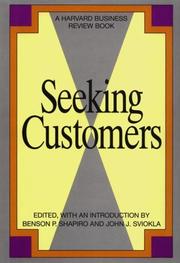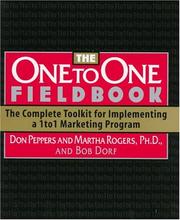| Listing 1 - 10 of 68 | << page >> |
Sort by
|
Book
ISBN: 1608052842 1608054195 9781608052844 Year: 2012 Publisher: Sharjah, United Arab Emirates : Bentham Science Publishers,
Abstract | Keywords | Export | Availability | Bookmark
 Loading...
Loading...Choose an application
- Reference Manager
- EndNote
- RefWorks (Direct export to RefWorks)
Consumers have been increasingly involved in the innovation process in the last few decades, a major driving force of business success. This involvement is critically important for innovation, particularly in product development. However, consumers frequently cannot articulate exactly what they need, want, or like if they are asked directly. It is very difficult for consumers to articulate their needs and desires. Therefore, researchers have to use other means to understand their motivations. There are many arguments suggesting that focus groups cannot create a reliable direction for new product development (NPD) or message optimization. A solution for this problem lies in a systematic, structured and disciplined experimentation with consumers - presenting them with a set of experimentally-designed products or concepts and soliciting their preferences. It is much easier for consumers to choose a preferred option from a set of concepts. New technologies make it easier than ever to conduct complex experiments quickly and inexpensively. The expanded use of experimentation provides an opportunity to take innovation to a new level. Rule Developing Experimentation (RDE) is an increasingly popular, structured, consumer-based experimentation methodology. RDE works with prototypes, either physical prototypes, prototypes created out of language (concepts), or prototypes created out of visual stimuli (design and packaging). In business, RDE is used both to understand existing products, product categories and packages, as well as to create next generation offerings in the process of new product development (NPD). Rule Developing Experimentation: A Systematic Approach to Understand & Engineer the Consumer Mind explains RDE concepts, beginning from its origins, to novel consumer research techniques and covers applications relevant to a real market context. Readers are also introduced to the concept of Mind Genomicsʼ - a more holistic approach to gaining insight into the consumer mind.
Book
ISBN: 3737600899 9783737600897 9783737600880 Year: 2016 Publisher: Kassel, Germany : Kassel University Press,
Abstract | Keywords | Export | Availability | Bookmark
 Loading...
Loading...Choose an application
- Reference Manager
- EndNote
- RefWorks (Direct export to RefWorks)
Als "Motor der Wirtschaft" wird derzeit permanentes Wachstum angesehen. Dieses stellt sich aber nicht von alleine ein, sondern ist von der stetigen Nachfrage der Konsumenten abhängig. Folglich wird von Seiten der Hersteller versucht, durchgängig Kaufanreize zu schaffen und zu erhalten, so z.B. mit schnellen Innovationszyklen, aber leider auch mit Maßnahmen geplanter Obsoleszenz. Problematisch ist dabei, dass hiermit auf der Produktionsseite ein enormer Verbrauch endlicher irdischer Rohstoffe sowie Umweltbelastungen einhergehen, die bereits heute u. a. in Gestalt des Klimawandels spürbar sind. Gleichzeitig entsteht dadurch, dass Verbraucher in sehr kurzen Abständen immer wieder die im Grunde gleichen Produkte erneut kaufen, ein Entsorgungsproblem, das bislang schon nicht gelöst i.
Consumer behavior. --- Consumers' preferences. --- Sustainable development.
Book
ISBN: 1282052306 0191521396 9786612052309 Year: 1987 Publisher: Oxford : Clarendon,
Abstract | Keywords | Export | Availability | Bookmark
 Loading...
Loading...Choose an application
- Reference Manager
- EndNote
- RefWorks (Direct export to RefWorks)
This book gathers together the various insights that Professor Afriat has gained into the problems of choice and value in economics, and is a definitive statement of his achievements in this field.
Economics --- Consumers' preferences --- Business & Economics --- Economic Theory
Book
ISBN: 2804147339 9782804147334 Year: 2005 Publisher: Bruxelles: De Boeck,
Abstract | Keywords | Export | Availability | Bookmark
 Loading...
Loading...Choose an application
- Reference Manager
- EndNote
- RefWorks (Direct export to RefWorks)
Neuromarketing. --- Marketing --- Consumers' preferences --- Neuropsychology. --- Psychological aspects. --- Consumers' preferences. --- Neuromarketing --- Neuropsychology --- Psychological aspects --- Marketing - Psychological aspects
Book
ISBN: 9781107458116 9781107087804 9781316104293 1107087805 1107458110 131610429X 1316494446 1316496759 Year: 2016 Volume: 56 Publisher: New York: Cambridge university press,
Abstract | Keywords | Export | Availability | Bookmark
 Loading...
Loading...Choose an application
- Reference Manager
- EndNote
- RefWorks (Direct export to RefWorks)
Pioneered by American economist Paul Samuelson, revealed preference theory is based on the idea that the preferences of consumers are revealed in their purchasing behavior. Researchers in this field have developed complex and sophisticated mathematical models to capture the preferences that are 'revealed' through consumer choice behavior. This study of consumer demand and behavior is closely tied up with econometrics (especially nonparametric econometrics), where testing the validity of different theoretical models is an important aspect of research. The theory of revealed preference has a very long and distinguished tradition in economics, but there was no systematic presentation of the theory until now. This book deals with basic questions in economic theory, such as the relation between theory and data, and studies the situations in which empirical observations are consistent or inconsistent with some of the best known theories in economics.
Revealed preference theory. --- Consumption (Economics) --- Consumers' preferences --- Consommation (Economie politique) --- Econometric models. --- Revealed preference theory --- Econometric models --- Consommateurs --- Préférences --- Préférences --- Consumers' preferences - Econometric models

ISBN: 0875843328 Year: 1993 Publisher: Cambridge (MA) ; London : Harvard Business Review,
Abstract | Keywords | Export | Availability | Bookmark
 Loading...
Loading...Choose an application
- Reference Manager
- EndNote
- RefWorks (Direct export to RefWorks)
Consumer satisfaction. --- Consumers' preferences. --- Selling. --- consumentengedrag --- klanten --- klantgerichtheid --- marktsegmentaties --- verkoop --- marketing, industrieel --- sales management --- Marketing --- Consumer preferences --- Consumer satisfaction --- Selling --- Consumers' preferences
Book
Year: 2019 Publisher: Johns Hopkins University Press
Abstract | Keywords | Export | Availability | Bookmark
 Loading...
Loading...Choose an application
- Reference Manager
- EndNote
- RefWorks (Direct export to RefWorks)
In contrast, companies that tried to stimulate desire, reshape taste, and encourage profligate spending by using the tools of persuasion - mass advertising, extravagant styling, and installment selling - found their efforts thwarted, for consumers refused to buy products that they did not really want."--Jacket. "Imagining Consumers is the first book to tell the story of American consumer society from the perspective of mass-market manufacturers and retailers. It relates the trials and tribulations of china and glassware producers in their contest for the hearts of working- and middle-class women, who by the 1920s made up more than 80 percent of those buying mass-manufactured goods. Following a model pioneered by Josiah Wedgwood during Great Britain's eighteenth-century industrial revolution, successful American manufacturers closely collaborated with retailers to sort out consumer priorities and tailored their products accordingly.
Consumers' preferences --- Glassware industry --- Ceramic tableware industry --- History of specific companies / corporate history --- History. --- USA.

ISBN: 9781591391456 1591391458 Year: 2007 Publisher: Boston (Mass.) Harvard Business School Press
Abstract | Keywords | Export | Availability | Bookmark
 Loading...
Loading...Choose an application
- Reference Manager
- EndNote
- RefWorks (Direct export to RefWorks)
"From Starbucks to the Geek Squad, from Venice to The Venetian, Authenticity examines how successful enterprises identify themselves with their customers' self-images and desires."--BOOK JACKET
Consumer behavior. --- Consumers' preferences. --- Product management. --- Consumentengedrag. --- Productmanagement. --- Marketing --- marketingbeleid --- business marketing --- marketing --- consumentengedrag --- Product management --- Consumer behavior --- Consumers' preferences --- Produits commerciaux --- Consommateurs --- Gestion --- Comportement --- Préférences --- Beleveniseconomie --- Productmanagement --- Consumentengedrag --- Psychologie van de consument --- Authenticiteit --- Consumentenpsychologie --- Financiewezen --- Attitude (psychologie)

ISBN: 0850861136 9780850861136 Year: 1984 Volume: 14 Publisher: London: Pion,
Abstract | Keywords | Export | Availability | Bookmark
 Loading...
Loading...Choose an application
- Reference Manager
- EndNote
- RefWorks (Direct export to RefWorks)
Economic geography --- Transport. Traffic --- Choice of transportation --- Housing --- Consumers' preferences --- Mathematical models --- Congresses --- Location --- Choice of transportation - Mathematical models - Congresses --- Housing - Location - Mathematical models - Congresses --- Consumers' preferences - Mathematical models - Congresses --- Geographie regionale

ISBN: 038549369X Year: 1999 Publisher: London, ... : Currency & Doubleday,
Abstract | Keywords | Export | Availability | Bookmark
 Loading...
Loading...Choose an application
- Reference Manager
- EndNote
- RefWorks (Direct export to RefWorks)
Consumers' preferences --- Market segmentation --- Relationship marketing --- Marketing --- Customer relations --- Niche marketing --- Segmented market --- Brand preferences --- Choice (Economic theory) --- Choice of product --- Preferences, Consumers' --- Product choice --- Consumer behavior --- Consumers --- Revealed preference theory --- Attitudes --- Consumers' preferences. --- Market segmentation. --- Relationship marketing.
| Listing 1 - 10 of 68 | << page >> |
Sort by
|

 Search
Search Feedback
Feedback About UniCat
About UniCat  Help
Help News
News